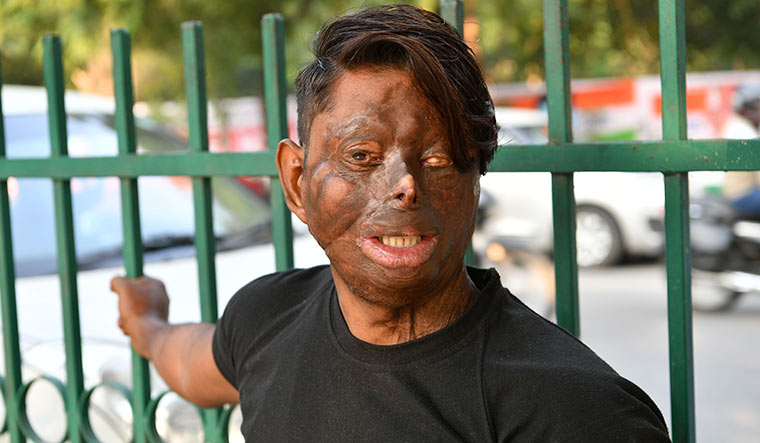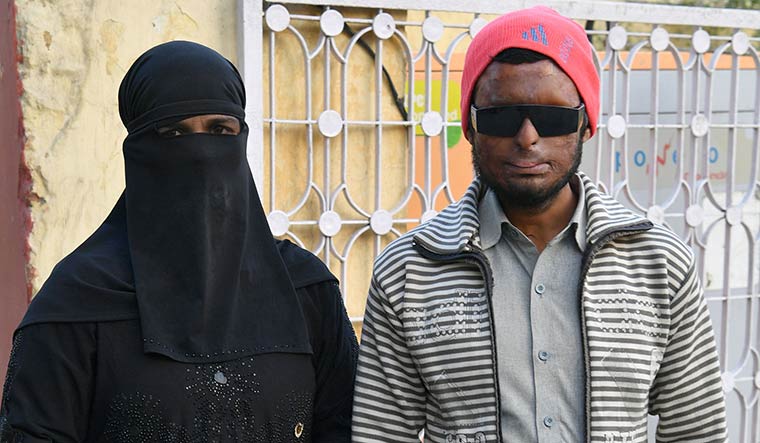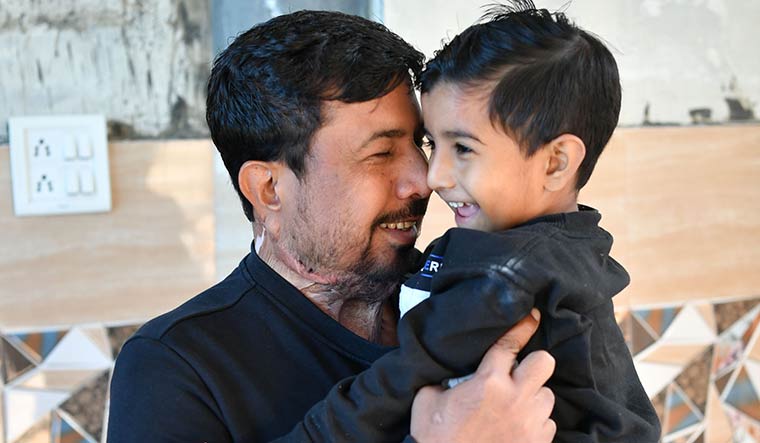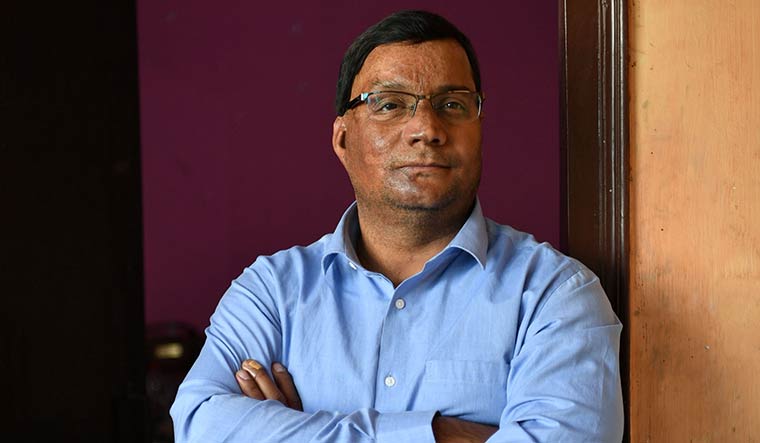The last visual memory that Shahnawaz has is of watching Shaktimaan—the Hindi serial about a superhero. He was five then. That night, as Shahnawaz lay asleep next to his mother, he sensed a searing heat on his face. “It felt as though someone had flung hot tea on me,” he recalls. “Then, a thousand electric currents began racing across my face. When I covered my face, my hands felt the same heat and then pain.”
Shahnawaz’s face had been bathed in acid. His alleged attacker, Kayyum, was a tenant of his father, Said Ahmed. The two had fallen out as Ahmed had asked Kayyum to vacate the house. Ahmed’s eldest daughter was to be married and the family needed money, for which they wanted to sell the house. On the night of the attack in August 1997, Ahmed, a cement supplier, was not at their home in Meerut. Well aware of the layout of the house—which has a courtyard with a gate that leads to the road outside—Kayyum, an electrician, had snapped the electricity connection and pocketed the keys to the courtyard gate. To reach the house, he had hopped over a row of connected terraces in the densely packed locality of Zaidi Farm. He waited on the roof till the night grew darker. When he jumped from the roof onto the courtyard, his mask slipped. Shahnawaz’s elder sister, who looked out on hearing the thud, saw him in the moonlight. Before she could cry out, he flung the liquid on Shahnawaz’s face and fled with the gate keys.
It was easy to identify where Shahnawaz slept—he was the only child on the cot; his four sisters had their bedding laid down on the floor. “Attacking me was his way to render my father useless,” says Shahnawaz. “Daughters get married and have other responsibilities. I was the only one who would have grown up to take care of my parents.”
Two hours passed before Shahnawaz was taken to the hospital. Though the family’s cries had brought the neighbours to their doorstep, no one could get in because the gate was locked. The only other way was to climb an electric pole and scale the courtyard wall. Neither the neighbours nor the family inside had the presence of mind to break open the door. It was Ahmed who, upon his return from Delhi, climbed the pole.
“He wrapped me in a thick blanket and took me to the nearest doctor,” recalls Shahnawaz. By then Shahnawaz’s mouth was full of blisters and though he desperately wanted to ask his father for reassurance, no words would come out. “That is what frightened me the most—that I would never be able to speak to my father,” he says. Later, the police found a glass bottle of acid, half empty, in a drain outside their home and a pair of slippers on the roof. “They [slippers] had been bought by my father for Kayyum,” says Shahnawaz. “My father thought of him as a son.”
Kayyum was subsequently arrested and jailed. Shahnawaz’s family, meanwhile, ran from Meerut to Hapur (in the National Capital Region) and then to Delhi for treatment. Months later, they would come to know that Kayyum had been granted bail. He is absconding since.
Shahnawaz is part of the larger untold story of acid attack survivors in India. He is a man. His attacker was not, as per common understanding, a rejected or disgruntled lover. He was the victim of a hate crime, which, though it claims more female victims, does not spare males.
On November 2016, Aslam Khan, 32, a native of Hapur and an e-rickshaw driver, was hired by three men to drop them off at a temple on the road that led from Hapur to Delhi. The men, however, kept asking him to go further from the destination, leading him to a deserted patch on the road. “One of them whipped out a knife and slashed my neck. Another flung acid on my face,” he says. “They took away my wallet and fled with my e-rickshaw. I had my mobile and pressed the last dialled number of a friend. I gave him my location and pleaded that he come and save me.” The attack left Aslam blind. Though his attackers were arrested, he is yet to receive any compensation despite having completed the requisite paperwork. His greatest worry is over the future of his three children, the youngest of whom is four. Tradition does not permit him to allow his wife, Reshma, to step out to work. Earlier, the family had a sewing machine on which Reshma worked on and off. It has since been sold off to fund Aslam’s frequent visits to Chennai for treatment at Sankara Nethralaya.
Another dominant thread in the narrative of acid survivors is that it is a crime committed only by men. So, on October 24, 2019, when a report was sought to be lodged against Muskaan Hilal, 19—who had flung acid on Faizad Zafar, 20—at the Quarsi police station in Aligarh, sub-inspector Lakhami Singh was stumped. “This is the first time I have come across such an incident,” says Singh, the investigating officer in the case. “The girl confessed that she had flung acid as the boy was refusing to marry her. Medical investigation has confirmed that the liquid used was acid—the kind that is used to clean toilets. The boy has lost vision in one eye.”
Three and a half years ago, acid was poured on to Meerut-based Umerdaraj’s neck; it was a woman who lured him to the site of the attack. He had a tiff with the local goon Irfan and his wife Rizwana had been calling Umerdaraj repeatedly to end the feud. “That day, too, it was she who called me for a meeting,” says Umerdaraj, 37. “As we stood talking, two strangers threw acid on my neck. I turned around. Some of it fell on my chest. It felt as though my heart would stop beating.” A father of four, he pulled his eldest child out of school in the aftermath of the attack, and took a loan of Rs1.5 lakh to undergo three surgeries. He needs more surgeries, but cannot afford them, he says. The District Legal Services Authority (DLSA) offered him Rs1 lakh as compensation. Though a FIR was filed against Irfan, Rizwana and two unknown persons, only Irfan was arrested. The police were unable to find Rizwana. Umerdaraj, meanwhile, keeps his neck covered and avoids going out as his neighbours call him ‘Jalawa’ (the burnt one) to his face.
In July 2013, the Supreme Court ruled that acid attack victims shall be paid a compensation of at least Rs3 lakh by the state government/Union territory towards after care and rehabilitation. Any victim compensation schemes in existence then or brought into effect post the ruling would have to comply with the said order. This was to be in addition to any fines to be paid under Section 326A (a section added to the Indian Penal Code in 2013, along with Section 326B to recognise, define and penalise acid attacks and attempts to attack with acid). None of these are gender-specific. But within the government and judicial apparatus, these are presumed to apply only to female victims.
In 2014, Chandrahass Mishra, 36, who had been attacked by acid in 2011, approached the DLSA in Meerut to claim compensation. He was told that there was no provision for male survivors. “This does not happen to men, they told me,” he says. The attacker was his landlord’s son, Akshay Khanna, who was miffed over Mishra’s constant objection to his indecent comments and actions towards women. Mishra had gone as far as threatening his attacker with a police complaint if he did not stop. “In school, I was part of the Scouts and Guide team. I have a sister and female cousins,” says Mishra. “It was only natural to object to indecent behaviour.”
The acid that had landed on the right side of Mishra’s face had scalded his scalp and ear before trickling down to his chest and arm. The medical measure of his burns was less than 40 per cent, and so he was not eligible for a disability certificate. After multiple surgeries and postoperative care burnt through his savings, he started his struggle for compensation. The police were clueless about it, as were the district magistrate’s office and the office of the chief medical officer. Mishra’s persistence with the DLSA got him 01 lakh under a generic compensation scheme applicable to victims of acid attack, rape, human trafficking and murder. His initial reaction was to reject it, but then he accepted it. Mishra’s is one of the 12 cases that lawyer Anuja Kapur has used to start a public interest litigation which, among other prayers, calls upon the Supreme Court to consider that “present laws involving acid attack are women-centric and gender-biased in nature”.
The broader plea of the PIL, titled Anuja Kapur vs Union of India and others, is to call upon state and Union territories to file their responses on what has been done on ground since acid attacks were recognised as a specific and separate form of crime. It thus asks for directions to be issued for maintenance of records related to “jobs and education, compensation, medical facilities and legal aid and services, provided to the victim of acid attack at the Central and state level”. It also called for termination of licenses of shopkeepers for illegal over-the-counter sale of acid.
Kapur, an advocate practising in the Supreme Court, says that till date, of the 42 respondents named in the PIL, only 28 have filed counter affidavits. Among those yet to respond are the ministry of health and family welfare and the state of Uttar Pradesh, which recorded the highest number of acid attacks as per the latest data released by the National Crime Records Bureau. “The law is handicapped as it is not serving its purpose,” says Kapur. On the last hearing of the PIL on August 5, 2019, the court directed the respondents to file responses within four weeks, failing which they would be liable to a penalty of Rs50,000. The next hearing is on January 24.
Meanwhile, Shahnawaz, who has never sought compensation, has a disability certificate that reads “He has got 100 per cent disability”. He has no vision in his left eye. The right one has some. The skin on his neck folds and crumbles, so it appears that his neck is fused to his face. He has difficulty moving his head. But he does not want his story to be one of pity or defeat. He has a hand-operated plastic moulding machine through which he makes a living. “I am very good at my work,” he says. “Tell me of a plastic part used anywhere, say, in a car, and I will make it for you. All I need is financial assistance to get an automatic machine that does a neater and quicker job.”
He clearly needs no superheroes to mould his future.





